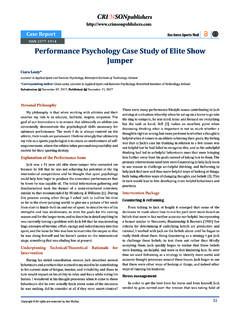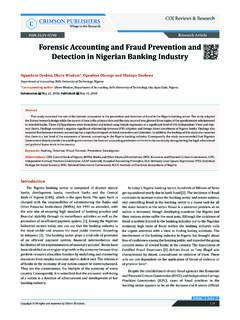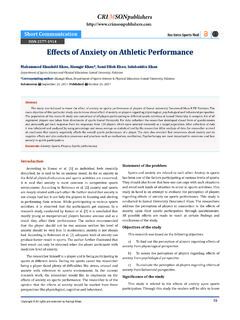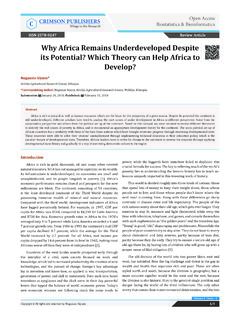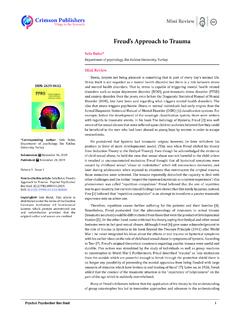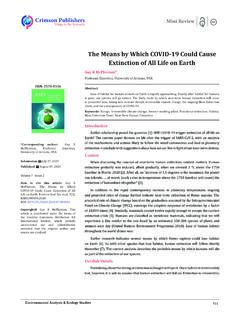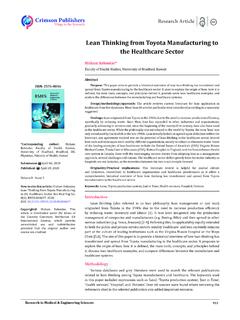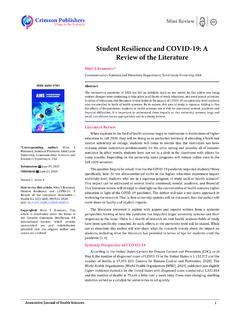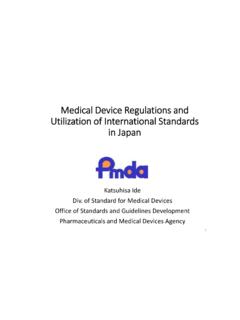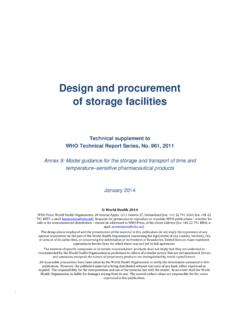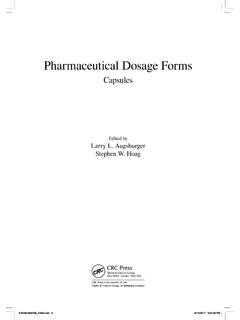Transcription of Safe Disposal of Slaughter House Waste
1 171 Malav OP*, Birla R, Virk KS, Sandhu HS, Mehta N, Kumar P and Wagh RVDepartment of Livestock products Technology, India*Corresponding author: Om Prakash Malav, Department of Livestock products Technology, College of Veterinary Science, , Ludhiana, Punjab, IndiaSubmission: September 01, 2017; Published: January 24, 2018 Safe Disposal of Slaughter House WasteCopyright All rights are reserved by Om Prakash House wastes are any discarded materials generated during production and processing of meat from live animals, it may be solid, liquid, and semi-solid material. These wastes are to be disposed of appropriately so as to prevent contamination of the environment and the serious consequences such as spread of diseases, foul smells and unaesthetic view. A major part of the Waste generated from the Slaughter houses constitutes the Byproducts which are handled by the animal by-products industry to produce many valuable products such as leather, casings, catgut, bone meal, meat meal, gelatin, Neat s foot oil, ornamental items etc.
2 Classification of Slaughter House WasteOn the basis of usage as food , the byproducts can be categorized into edible and non-edible, however, some of the byproducts have medicinal values and classed under pharmaceutical category. Edible by products generally include all those organs which can be consumed viz. liver, lungs, heart, brain, intestine etc. They are also known as variety meats or fancy meat . All those by products that cannot be consumed directly as food are non-edible byproducts hides, horns, ears, hooves, nails, bristles etc. All the condemned parts of animal carcass also fall in this category. This demarcation of edible and non-edible byproducts is not universally acceptable as it is largely dependent on customs, traditions, purchasing power, food choices etc. of consumers. In one region, consumption of a particular by product may be a taboo and in other region it may be a delicacy. The yield of edible by-products from animals varies tremendously depending on species, sex, live weight, fatness and methods of collection.
3 In general, the total by-products range from 10% to 30% of the live weight for beef, pork and lamb and from 5% to 6% of the live weight of chickens [1]. The yield of edible by-products including blood and organs in cattle averages 12%, in sheep 14%, and, if pork rinds are also included, 14% for hogs. The consumption of offal is also influenced by disease outbreaks and government policies brain and spinal cord were out of the list for consumption since the outbreak of BSE (Mad cow disease). On the basis of live weight of animal the by-products account for almost 60% and out of this 40% are edible and 20% are inedible [2].The byproducts can also be divided into primary and secondary by products. Primary by products also known as principal byproducts are harvested directly from the animals whereas the secondary byproducts are derived from principal byproducts Bones are primary by products whereas gelatin is secondary by product .
4 The secondary byproducts have a huge market and yield large revenues. Another basis of classification of animal byproducts is their ultimate use. It includes agricultural byproducts (meat meal, fertilizers etc.), industrial by products (gelatin, glue etc.) and pharmaceutical byproducts such as hormones, bio-chemicals etc. [3].On the basis of consistent of Waste generated from the abattoir, it may be classified as solid and liquid Waste . Solid Waste includes edible and non-edible offal, hide and skin, dung, GIT contents, left over feed, hairs, bristles etc, whereas the liquid Waste include effluent generated from Slaughter houses which is the Waste water originated from the different slaughtering and dressing House Waste or byproducts are to be disposed of or utilized appropriately so as to prevent contamination of the environment and the formation of valuable products which may increase the income of the abattoir and livestock owners.
5 Both Solid and liquid wastes generated from the Slaughter houses and animal processing plants having high nutritive value, therefore the Biochemical oxygen demand (BOD) is very high and these have high polluting potential when directly let into to the main water courses and environment. There are different methods for the treatment and processing of these wastes which reduces their polluting potential and these may be converted into useful products. The Slaughter House byproducts consisting of heads, feet, offal, bone, hair, blood and feathers may be processed in rendering plants producing meat meal, bone meal, carcass meal, tallow and degreased bone. Efficient utilization of animal by-products has direct impact on the economy and environmental pollution of the country. Non- utilization or under- utilization of by-products not only lead to loss of potential revenues but also lead to the added and increasing cost of Disposal of these products along with major aesthetic and serious health ReviewApproaches in Poultry, Dairy & Veterinary SciencesCCRIMSON PUBLISHERSW ings to the ResearchISSN: 2576-9162 How to cite this article: Malav OP, Birla R, Virk KS, Sandhu HS, Mehta N, Kumar P, Wagh RV.
6 Safe Disposal of Slaughter House Waste . Appro Poult Dairy & Vet Sci. 2(4). 2018. DOI: in Poultry, Dairy & Veterinary Sciences 172 Appro Poult Dairy & Vet SciTreatment of Solid Wastes from Slaughter HousesMethods of handling viscera, paunch and intestinesViscera can be recovered as edible products ( heart, liver, lung). They can also be separated for inedible rendering or processing. The paunch contents, paunch manure (partially digested feed), is estimated to range from 27 to 40kg/animal. The paunch can be handled in four ways: Total dumping- all of the paunch contents are flushed away into the sewer, wet dumping- the paunch contents are washed out and the wet slurry is screened on the presence of gross solids, which are subsequently removed, dry dumping. The paunch contents are dumped for subsequent rendering or for Disposal as solid Waste without needless water flushing, whole paunch handling- the entire paunch may be removed, intact, for rendering or for Disposal as solid Waste .
7 Intestines may be rendered directly, or hashed and washed prior to gas productionDue to the abundant biomass wastes generated by slaughterhouse, these biomass resources potential for biogas production by the process of biomethenation, this process use slaughterhouse Waste for production of biogas. The success of the process, especially the effective removal BOD has led biogas plant to be acceptable for Slaughter House [4]. Wastes consisting of rumen and paunch contents, dung, agriculture residue, fat and blood are processed in biomethenation plant. Power plants have been designed to produce biogas (60% methane, 30% carbon dioxide and traces of hydrogen, carbon monoxide etc.) by digestion of animal Waste [5]. The biogas can be used for boiler or power Slaughter House are mostly located around cities and congested areas. They generate substantial quality of solid wastes, which have to be processed in environmentally acceptable manner.
8 For the large Slaughter houses, bio-methanation of Waste is suggested. Bio-methanation requires less space, which is advantageous for the Slaughter houses with land constraints. Bio gas produced from this operation may fulfill the energy requirements of Slaughter unit and adjoining involves the aerobic biological decomposition of organic materials to produce a stable humus-like product . The Slaughter House Waste can be used for compost making. The left over feed, dung from the lair age, ruminal and intestinal contents, blood, meat trimmings, floor sweepings, hair, feathers, hide trimmings can be stabilized by composting. It will produce very good quality bio-manure which may be utilized as fertilizers for the agriculture land and gardens. RenderingThis is a useful method for the physical separation of fats from solids and water. All the animal matter such as inedible offal, tissues, meat trimmings, Waste and condemned meat, bones etc.
9 Can be processed in a rendering system as the main constituents of animal matter are fat, water and solids. Rendering is affected by heating and rupturing connective tissue of individual fat and muscle cells so that raw fat and other material bound within is freed. In rendering, fat recovered is used for industrial purposes, such as soap and greases. Fat recovered from flesh of healthy parts can also be used for edible purposes. Solid portion, which is known as meat meal or bone meal, is utilized for the manufacture of stock feed and fertilizers. Rendering is carried out in dry rendering or wet rendering plantsEffective utilization of slaughterhouse byproductsEfficient utilization of by-products has direct impact on the economy and environmental pollution of the country. Non- utilization or underutilization of by-products not only lead to loss of potential revenues but also lead to the added and increasing cost of Disposal of these products.
10 Non- utilization of animal by-products in a proper way may create major aesthetic and catastrophic health problems. Besides pollution and hazard aspects, in many cases meat, poultry and fish processing wastes have a potential for recycling raw materials or for conversion into useful products of higher value. Traditions, culture and religion are often important when a meat by- product is being utilized for food . By-products such as blood, liver, lung, kidney, brains, spleen and tripe have good nutritive value. Technologies have been developed for number of high value products like collagen sheets, tallow, keratin hydrolysates, ossein, pet foods, animal feeds etc. from different Slaughter House byproducts. Other important product that can be prepared Slaughter House byproducts include leather, carcass meal, rendered fat, sausage casings, blood meal, horn and hoof meal of effluent - the liquid wasteEffluent is the Waste water generated from the meat processing plant.
